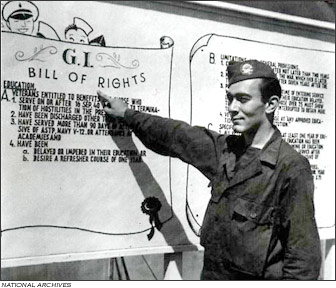
The GI Bill
First proposed by the American Legion and passed by Congress on January 10, 1944, the GI Bill of Rights–more formally known as the Servicemen’s Readjustment Act of 1944–was intended to smooth demobilization for America’s almost 16 million servicemen and women. Postwar college and vocational school attendance soared as more than 50 percent of honorably discharged veterans took advantage of education benefits of up to $500 a year for tuition, plus a living allowance.
When they returned home to marry and start families in record numbers, veterans faced a severe housing shortage. The home loan provisions of the GI Bill provided more than 2 million home loans and created a new American landscape in the suburbs. In 1990, President George Bush summed up the impact of the GI Bill: ‘The GI Bill changed the lives of millions by replacing old roadblocks with paths of opportunity.’




